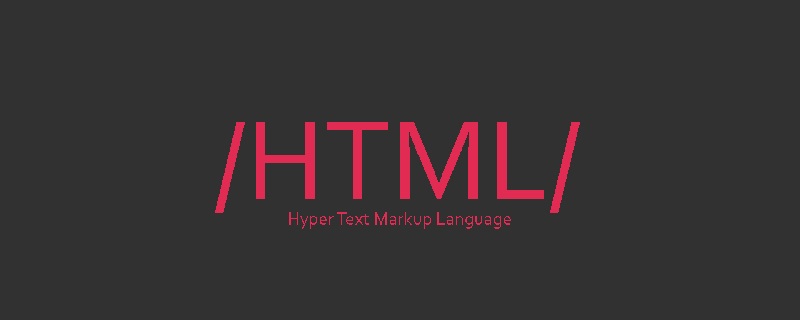HTML documents are defined by HTML elements.
HTML Element Syntax
HTML element starts with a start tag
HTML element ends with an end tag
The content of the element is the sum of the start tag and the end tag Content between
Some HTML elements have empty content
Empty elements are closed in the start tag (end with the end of the start tag)
Large Most HTML elements can have attributes
Note: You will learn more about attributes in the next chapter of this tutorial.
Nested HTML Elements
HTML documents are composed of nested HTML elements. HTML document example The above example contains three HTML elements. HTML instance parsing The element: This element defines a paragraph in the HTML document. and an end tag <!DOCTYPE html>
<html>
<body>
<p>This is my first paragraph.</p>
</body>
</html>
<p>This is my first paragraph.</p>
This element has a start tag
The content of the element is: This is my first paragraph.
The
element:<p>This is my first paragraph.</p>
The
element defines the body of the HTML document.This element has a start tag and an end tag . The
element content is another HTML element (p element).
The element:
<p>This is my first paragraph.</p>
The element defines the entire HTML document.
This element has a start tag and an end tag .
The content of the element is another HTML element (body element).
Don’t forget the closing tag
Even if you forget to use the closing tag, most browsers will display the HTML correctly:
This is a paragraph
This is a paragraph
The above example can also be displayed normally in the browser because the closing tag is optional.
But don’t rely on this approach. Forgetting to use a closing tag can produce unpredictable results or errors.
HTML Empty Element
An HTML element with no content is called an empty element. Empty elements are closed in the opening tag.
is an empty element without a closing tag (
tag definition wraps).
In XHTML, XML, and future versions of HTML, all elements must be closed.
Adding a slash in the opening tag, such as
, is the correct way to close an empty element, and is accepted by HTML, XHTML, and XML.
Even though
is valid in all browsers, using
is actually a longer-term guarantee.
HTML Tip: Use lowercase tags
HTML tags are not case-sensitive:
is equivalent to
. Many websites use uppercase HTML tags.
W3CSchool uses lowercase tags because the World Wide Web Consortium (W3C) recommended lowercase in HTML 4 and will mandate lowercase in a future version of (X)HTML.
【related suggestion】
1. Special recommendation: "php Programmer Toolbox" V0.1 version download
2. Free html online video tutorial
##3.php.cn original html5 videotutorial
The above is the detailed content of Basic introduction to HTML elements. For more information, please follow other related articles on the PHP Chinese website!
 HTML超文本标记语言--超在那里?(文档分析)Aug 02, 2022 pm 06:04 PM
HTML超文本标记语言--超在那里?(文档分析)Aug 02, 2022 pm 06:04 PM本篇文章带大家了解一下HTML(超文本标记语言),介绍一下HTML的本质,HTML文档的结构、HTML文档的基本标签和图像标签、列表、表格标签、媒体元素、表单,希望对大家有所帮助!
 html和css算编程语言吗Sep 21, 2022 pm 04:09 PM
html和css算编程语言吗Sep 21, 2022 pm 04:09 PM不算。html是一种用来告知浏览器如何组织页面的标记语言,而CSS是一种用来表现HTML或XML等文件样式的样式设计语言;html和css不具备很强的逻辑性和流程控制功能,缺乏灵活性,且html和css不能按照人类的设计对一件工作进行重复的循环,直至得到让人类满意的答案。
 web前端笔试题库之HTML篇Apr 21, 2022 am 11:56 AM
web前端笔试题库之HTML篇Apr 21, 2022 am 11:56 AM总结了一些web前端面试(笔试)题分享给大家,本篇文章就先给大家分享HTML部分的笔试题(附答案),大家可以自己做做,看看能答对几个!
 HTML5中画布标签是什么May 18, 2022 pm 04:55 PM
HTML5中画布标签是什么May 18, 2022 pm 04:55 PMHTML5中画布标签是“<canvas>”。canvas标签用于图形的绘制,它只是一个矩形的图形容器,绘制图形必须通过脚本(通常是JavaScript)来完成;开发者可利用多种js方法来在canvas中绘制路径、盒、圆、字符以及添加图像等。
 html中document是什么Jun 17, 2022 pm 04:18 PM
html中document是什么Jun 17, 2022 pm 04:18 PM在html中,document是文档对象的意思,代表浏览器窗口的文档;document对象是window对象的子对象,所以可通过“window.document”属性对其进行访问,每个载入浏览器的HTML文档都会成为Document对象。
 html5废弃了哪个列表标签Jun 01, 2022 pm 06:32 PM
html5废弃了哪个列表标签Jun 01, 2022 pm 06:32 PMhtml5废弃了dir列表标签。dir标签被用来定义目录列表,一般和li标签配合使用,在dir标签对中通过li标签来设置列表项,语法“<dir><li>列表项值</li>...</dir>”。HTML5已经不支持dir,可使用ul标签取代。
 Html5怎么取消td边框May 18, 2022 pm 06:57 PM
Html5怎么取消td边框May 18, 2022 pm 06:57 PM3种取消方法:1、给td元素添加“border:none”无边框样式即可,语法“td{border:none}”。2、给td元素添加“border:0”样式,语法“td{border:0;}”,将td边框的宽度设置为0即可。3、给td元素添加“border:transparent”样式,语法“td{border:transparent;}”,将td边框的颜色设置为透明即可。


Hot AI Tools

Undresser.AI Undress
AI-powered app for creating realistic nude photos

AI Clothes Remover
Online AI tool for removing clothes from photos.

Undress AI Tool
Undress images for free

Clothoff.io
AI clothes remover

AI Hentai Generator
Generate AI Hentai for free.

Hot Article

Hot Tools

mPDF
mPDF is a PHP library that can generate PDF files from UTF-8 encoded HTML. The original author, Ian Back, wrote mPDF to output PDF files "on the fly" from his website and handle different languages. It is slower than original scripts like HTML2FPDF and produces larger files when using Unicode fonts, but supports CSS styles etc. and has a lot of enhancements. Supports almost all languages, including RTL (Arabic and Hebrew) and CJK (Chinese, Japanese and Korean). Supports nested block-level elements (such as P, DIV),

Dreamweaver CS6
Visual web development tools

SublimeText3 Mac version
God-level code editing software (SublimeText3)

SublimeText3 Linux new version
SublimeText3 Linux latest version

SublimeText3 English version
Recommended: Win version, supports code prompts!







